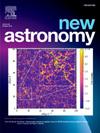MeerKAT-based multi-wavelength study of supernova remnant G7.7-3.7 (SN386?)
IF 2.1
4区 物理与天体物理
Q2 ASTRONOMY & ASTROPHYSICS
引用次数: 0
Abstract
We investigated the structural characteristics of G7.7-3.7 at a higher resolution of 1284 MHz. MeerKAT observations revealed that G7.7-3.7 had an asymmetric spherical structure with filamentary features and various blowouts. The western boundary showed a strong bright blowout, while the southern perimeter showcased extended bright filaments with feather-like structures, which seemed disconnected from the western blowout. Moreover, the eastern region exhibited a blowout centered around a bright point source, with faint, elongated filaments extending north-west. These filaments connected the eastern point source to the western blowout, creating a uniform outward progression. Spectral index analysis indicated a steep spectrum ( ranged 0 to −3), suggesting a combination of synchrotron and a few traces of thermal emissions concentrated at the edges of bright blowouts. Analysis of MeerKAT and VLA data revealed that G7.7-3.7 had expanded by 9 ± 0.45 arcsec over a period of 31.907 years, corresponding to an expansion rate of 0.282 ± 0.014 arcsec yr−1. This expansion indicated a shock speed of 5883 ± 294 km s−1 and an age of 1636 ± 115 years. This age fits with the supernova explosion event of 386 CE and the MeerKAT observed data in 2023. The multi-wavelength investigation unveiled a distinctive structure within the southern radio blowout, encompassing a bright radio blowout, a prominent X-ray arc, and two faint optical filaments aligned with the X-ray bright arc. We attributed the bright radio blowouts to inhomogeneous mass outflow from shock-accelerated particles and the weakening of magnetic fields along its perimeter. Traces of thermal emissions, especially along the edges of blowouts, were likely due to shock-heated gas, which intensified in the southern region amid high-density Interstellar Medium (ISM). Therefore, these results supported a scenario in which the progenitor supernova of G7.7-3.7 exploded within ISM of varying density, generating the observed X-ray emissions and faint optical filaments. Our findings provided valuable insights into the dynamics and evolution of supernova remnants.
基于meerkat的超新星遗迹G7.7-3.7 (SN386?)多波长研究
我们研究了G7.7-3.7在1284 MHz高分辨率下的结构特性。MeerKAT观测显示,G7.7-3.7具有不对称的球形结构,具有丝状特征和各种喷气孔。西部边界显示出一个强烈的明亮爆点,而南部边缘显示出带有羽毛状结构的延伸明亮细丝,似乎与西部爆点断开了连接。此外,东部地区以一个明亮的点源为中心出现了井喷,微弱的细长细丝向西北方向延伸。这些细丝将东部的点源与西部的井喷连接起来,形成了一个统一的向外发展。光谱指数分析显示了一个陡峭的光谱(α范围为~ 0到~−3),表明同步加速器和集中在明亮爆炸边缘的少量热发射痕迹的结合。MeerKAT和VLA数据分析表明,G7.7-3.7在31.907 a的周期内扩展了9±0.45 arcsec,对应的扩展速率为0.282±0.014 arcsec /年。这一膨胀表明其激波速度为5883±294 km s−1,年龄为1636±115年。这个年龄与386ce的超新星爆炸事件和2023年MeerKAT的观测数据相吻合。多波长的研究揭示了南部射电暴中一个独特的结构,包括一个明亮的射电暴,一个突出的x射线弧,以及两个与x射线亮弧排列的微弱光学丝。我们将明亮的射电爆发归因于激波加速粒子的不均匀质量流出以及其周围磁场的减弱。热排放的痕迹,特别是在爆炸边缘,可能是由于激波加热的气体,在高密度星际介质(ISM)的南部地区加剧。因此,这些结果支持了一种假设,即G7.7-3.7的前身超新星在不同密度的ISM中爆炸,产生了观测到的x射线辐射和微弱的光学细丝。我们的发现为超新星遗迹的动力学和演化提供了有价值的见解。
本文章由计算机程序翻译,如有差异,请以英文原文为准。
求助全文
约1分钟内获得全文
求助全文
来源期刊

New Astronomy
地学天文-天文与天体物理
CiteScore
4.00
自引率
10.00%
发文量
109
审稿时长
13.6 weeks
期刊介绍:
New Astronomy publishes articles in all fields of astronomy and astrophysics, with a particular focus on computational astronomy: mathematical and astronomy techniques and methodology, simulations, modelling and numerical results and computational techniques in instrumentation.
New Astronomy includes full length research articles and review articles. The journal covers solar, stellar, galactic and extragalactic astronomy and astrophysics. It reports on original research in all wavelength bands, ranging from radio to gamma-ray.
 求助内容:
求助内容: 应助结果提醒方式:
应助结果提醒方式:


